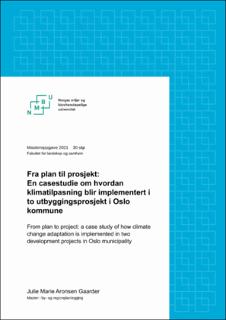| dc.contributor.advisor | Hanssen, Gro Sandkjær | |
| dc.contributor.author | Gaarder, Julie Marie Aronsen | |
| dc.coverage.spatial | Norway, Oslo | en_US |
| dc.date.accessioned | 2021-12-29T10:16:43Z | |
| dc.date.available | 2021-12-29T10:16:43Z | |
| dc.date.issued | 2021 | |
| dc.identifier.uri | https://hdl.handle.net/11250/2835559 | |
| dc.description.abstract | En effekt av klimaendringene i Norge er at nedbøren øker vesentlig, både i intensitet og hyppighet. Dette kombinert med en stadig fortetting av byer og tettsteder har ført til økte problemer med overvann. Konsekvensene dette fører med seg er allerede synlige etter større nedbørshendelser i dag, og om samfunnet ikke begynner å tilpasse seg vil problemene og skadene øke i omfang.
Som en løsning på dette har åpne overvannsløsninger begynt å vokse frem, hvor stadig flere kommuner har begynt å stille krav til åpne og lokale overvannsløsninger i sine overordnede planer. Dette krever imidlertid et tverrfaglig samarbeid, og trekker en rekke nye profesjoner og etater inn i planleggingen. Samtidig gjøres hovedsakelig detaljplanleggingen og gjennomføringen av private aktører.
På bakgrunn av dette undersøker oppgaven hvordan overordnede intensjoner om klimatilpasning blir implementert og oversatt videre i detaljreguleringsprosesser og prosjektutviklingen av nye utbyggingsprosjekter. Det undersøkes også hvordan planleggingen kan gi rammer for et godt samspill mellom de involverte aktørene og fagprofesjonene. Problemstillingen utforskes gjennom en casestudie av Oslo kommune og to nyere utbyggingsprosjekt i kommunen. Dette gjøres ved hjelp av dokumentstudier av reguleringsplanene, byggesaksprosessen og intervju.
Funnene viser at Oslo kommune har kommet langt med å institusjonalisere klimatilpasning i sine planer og strategier. Utbyggingsprosjektene samsvarer med hvordan kommunen tolker og håndhever kravene. Kommunen har en forståelse for den stedlige konteksten som vanskeliggjør implementering helt etter kravene, ved at de prosjekterende skal redegjøre for at de har gjort så mye som mulig før man tyr til alternative løsninger i trinn 2 av 3- trinnsstrategien. Videre viser funnene at kravene kommunen stiller på et overordnet nivå er avgjørende for å sikre implementering videre i prosjektene. Funnene viser også at de prosjekterende kan få et større handlingsrom ved at det stilles mer spesifikke og tydelige krav, og at dette bidrar til å implementere nye åpne overvannsløsninger. Studien viser at utfordringene med implementering knytter seg til de stedlige forutsetningene på tomten, og at det først er i byggesaken kravene kommer til syne og blir tegnet ut. Til slutt kommer det fram at dette også krever en god samordning internt i kommunen, når kommunen skal bruke sin reguleringsmyndighet til å stille krav til de private aktørene. | en_US |
| dc.description.abstract | One of the effects of climate change in Norway is a significant increase in precipitation. These changes, combined with densification of cities lead to an increase in problems related to surface water runoff. The consequences of this are already visible after severe rainfalls today, and if society does not begin to adapt, the problems and the following damages will escalate.
As a response to these challenges, open blue-green stormwater solutions have emerged. Municipalities have increasingly begun to set policies and regulations to implement these solutions in their municipal plans. However, implementation requires interdisciplinary collaboration which involves a number of new professions and municipal agencies in the planning process. At the same time, the detailed planning and actual implementation are mainly initiated by private developers.
The aim of this thesis is to examine how intentions of climate change adaptation are implemented and translated into the detailed zoning process and the project development phase. Further, it investigates how planning can provide a good framework for collaboration between the involved actors and professionals. The research questions are explored through a case study of Oslo Municipality and two recent development projects, using a document study of the zoning plans, building permit process and interviews.
The findings show that Oslo has institutionalized climate change adaptation regulations in its plans and strategies. The two development projects correspond along with how the Municipality interprets the regulations. The analysis shows that the Municipality has an understanding of the local context that makes it difficult to implement the policies, and requires the designers to show that they have done everything they can before it is applicable to use alternative stormwater solutions. Furthermore, it is clear that the requirements set by the municipality at an overall level are crucial in ensuring implementations in the projects. The findings also show that more specific provisions can give the designers an enlarged opportunity space and push the designers to implement new open stormwater solutions. The challenges of implementation are related to the site-specific conditions and that is first in the building permit process the provisions become evident. The results also show that implementation requires the municipality to maintain a certain level of coordination internally as they use their authority to set regulations for private developers. | en_US |
| dc.language.iso | nob | en_US |
| dc.publisher | Norwegian University of Life Sciences, Ås | en_US |
| dc.rights | Attribution-NonCommercial-NoDerivatives 4.0 Internasjonal | * |
| dc.rights.uri | http://creativecommons.org/licenses/by-nc-nd/4.0/deed.no | * |
| dc.title | Fra plan til prosjekt : en casestudie om hvordan klimatilpasning blir implementert i to utbyggingsprosjekt i Oslo kommune | en_US |
| dc.title.alternative | From plan to project : a case study of how climate change adaptation is implemented in two development projects in Oslo municipality | en_US |
| dc.type | Master thesis | en_US |
| dc.description.localcode | M-BYREG | en_US |

